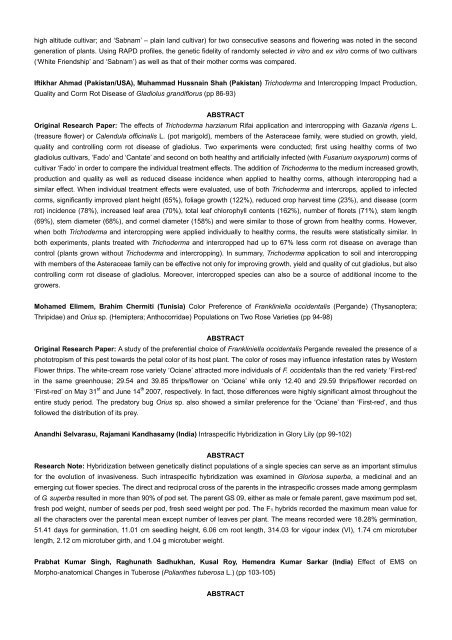Issue infomation - Global Science Books
Issue infomation - Global Science Books
Issue infomation - Global Science Books
Create successful ePaper yourself
Turn your PDF publications into a flip-book with our unique Google optimized e-Paper software.
high altitude cultivar; and ‘Sabnam’ – plain land cultivar) for two consecutive seasons and flowering was noted in the second<br />
generation of plants. Using RAPD profiles, the genetic fidelity of randomly selected in vitro and ex vitro corms of two cultivars<br />
(‘White Friendship’ and ‘Sabnam’) as well as that of their mother corms was compared.<br />
Iftikhar Ahmad (Pakistan/USA), Muhammad Hussnain Shah (Pakistan) Trichoderma and Intercropping Impact Production,<br />
Quality and Corm Rot Disease of Gladiolus grandiflorus (pp 86-93)<br />
ABSTRACT<br />
Original Research Paper: The effects of Trichoderma harzianum Rifai application and intercropping with Gazania rigens L.<br />
(treasure flower) or Calendula officinalis L. (pot marigold), members of the Asteraceae family, were studied on growth, yield,<br />
quality and controlling corm rot disease of gladiolus. Two experiments were conducted; first using healthy corms of two<br />
gladiolus cultivars, ‘Fado’ and ‘Cantate’ and second on both healthy and artificially infected (with Fusarium oxysporum) corms of<br />
cultivar ‘Fado’ in order to compare the individual treatment effects. The addition of Trichoderma to the medium increased growth,<br />
production and quality as well as reduced disease incidence when applied to healthy corms, although intercropping had a<br />
similar effect. When individual treatment effects were evaluated, use of both Trichoderma and intercrops, applied to infected<br />
corms, significantly improved plant height (65%), foliage growth (122%), reduced crop harvest time (23%), and disease (corm<br />
rot) incidence (78%), increased leaf area (70%), total leaf chlorophyll contents (162%), number of florets (71%), stem length<br />
(69%), stem diameter (68%), and cormel diameter (158%) and were similar to those of grown from healthy corms. However,<br />
when both Trichoderma and intercropping were applied individually to healthy corms, the results were statistically similar. In<br />
both experiments, plants treated with Trichoderma and intercropped had up to 67% less corm rot disease on average than<br />
control (plants grown without Trichoderma and intercropping). In summary, Trichoderma application to soil and intercropping<br />
with members of the Asteraceae family can be effective not only for improving growth, yield and quality of cut gladiolus, but also<br />
controlling corm rot disease of gladiolus. Moreover, intercropped species can also be a source of additional income to the<br />
growers.<br />
Mohamed Elimem, Brahim Chermiti (Tunisia) Color Preference of Frankliniella occidentalis (Pergande) (Thysanoptera;<br />
Thripidae) and Orius sp. (Hemiptera; Anthocorridae) Populations on Two Rose Varieties (pp 94-98)<br />
ABSTRACT<br />
Original Research Paper: A study of the preferential choice of Frankliniella occidentalis Pergande revealed the presence of a<br />
phototropism of this pest towards the petal color of its host plant. The color of roses may influence infestation rates by Western<br />
Flower thrips. The white-cream rose variety ‘Ociane’ attracted more individuals of F. occidentalis than the red variety ‘First-red’<br />
in the same greenhouse; 29.54 and 39.85 thrips/flower on ‘Ociane’ while only 12.40 and 29.59 thrips/flower recorded on<br />
‘First-red’ on May 31 st and June 14 th 2007, respectively. In fact, those differences were highly significant almost throughout the<br />
entire study period. The predatory bug Orius sp. also showed a similar preference for the ‘Ociane’ than ‘First-red’, and thus<br />
followed the distribution of its prey.<br />
Anandhi Selvarasu, Rajamani Kandhasamy (India) Intraspecific Hybridization in Glory Lily (pp 99-102)<br />
ABSTRACT<br />
Research Note: Hybridization between genetically distinct populations of a single species can serve as an important stimulus<br />
for the evolution of invasiveness. Such intraspecific hybridization was examined in Gloriosa superba, a medicinal and an<br />
emerging cut flower species. The direct and reciprocal cross of the parents in the intraspecific crosses made among germplasm<br />
of G. superba resulted in more than 90% of pod set. The parent GS 09, either as male or female parent, gave maximum pod set,<br />
fresh pod weight, number of seeds per pod, fresh seed weight per pod. The F 1 hybrids recorded the maximum mean value for<br />
all the characters over the parental mean except number of leaves per plant. The means recorded were 18.28% germination,<br />
51.41 days for germination, 11.01 cm seedling height, 6.06 cm root length, 314.03 for vigour index (VI), 1.74 cm microtuber<br />
length, 2.12 cm microtuber girth, and 1.04 g microtuber weight.<br />
Prabhat Kumar Singh, Raghunath Sadhukhan, Kusal Roy, Hemendra Kumar Sarkar (India) Effect of EMS on<br />
Morpho-anatomical Changes in Tuberose (Polianthes tuberosa L.) (pp 103-105)<br />
ABSTRACT
















